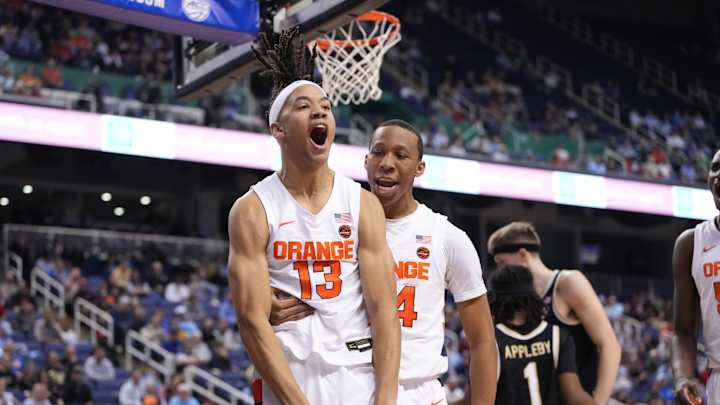Assessing and Projecting: Benny Williams Versus Wake Forest

In this story:
It’s been an up-and-down season for Syracuse sophomore Benny Williams, but his tools and flashes as a 6-foot-8 big wing remain compelling.
In what was a tough loss to Wake Forest on a buzzer-beating three by Daivien Williamson, Williams delivered his second double-double of the season and nearly led Syracuse to victory. Let’s assess the takeaways from his performance and how it affects his future draft stock:
Size and Shotmaking Combination
Teams are always searching for size and shotmaking. At 6-foot-8 and 206 pounds, Williams showcased his ability to knock down with some splashes of versatility. He knocked down three triples off catch-and-shoots along with a movement mid-range jumper. One of his threes put Syracuse ahead 74-72 with about a minute left, but the team was unable to close it out.
Williams was decisive and confident in his shot throughout the game, misses didn’t deter him, and he often ended up with quality looks that I'll take any day from him.
Although it’s on a fairly small volume (1.6 attempts per game and 48 total attempts), Williams is shooting at a 39% clip from deep this season. I’m sure NBA teams want to see an uptick in threes next season but must be thrilled about the jump as a shooter he’s made this season after connecting on just 1-of-11 threes last season as a freshman.
Whether it’s returning to Syracuse alongside or without star freshman Judah Mintz, who will have to decide if he wants to turn pro, or possibly entering the transfer portal, Williams should be in line for more usage and opportunities to grow as a shot maker and shot creator.
Defensive Playmaking
Five steals and a block point directly to Williams’ potential to develop into a disruptive defender thanks to a combination of physical tools and effort.
He was excellent at leveraging his size, length and athleticism to make plays on and off the ball that not only resulted in stops, but scores for Syracuse on multiple occasions. Williams is generating 1.1 stocks per game, an encouraging mark that I’ll be closely monitoring for improvement next season. His upside, a disruptive and switchable defender as a big wing, fits right into the NBA.
Second Chance Opportunities
Williams’ activity poured into his rebounding, particularly offensively. He was relentless on the offensive glass, rebounding both in and out his area, to corral a season-high tying five offensive rebounds. From establishing good rebounding position to flat out sprinting to crash the glass and out hustling defenders with his energy and effort, he created valuable second chance points and opportunities for himself and teammates that kept Syracuse in the game.
Consistently hunting offensive rebounds with this type of activity and spirit would add another way Williams can impact the game without needing the ball in his hands. Giving up second chance opportunities and opportunities can demoralize opposing teams, especially in crucial situations. With an expected increase in minutes next season from his 22.3 minutes per game, it’s reasonable to expect his 1.2 offensive rebounds per game average to rise as well, perhaps around two per game.
Want to join the discussion? Like Draft Digest on Facebook and follow us on Twitter to stay up to date on all the latest NBA Draft news. You can also meet the team behind the coverage.

Jam is a scout with nearly a decade of evaluation experience through his time with former NBA scouting and consulting services, EV Hoops and BPA Hoops. From the high school to NBA level, he brings a wealth of knowledge on prospects.
Follow jamontheboards